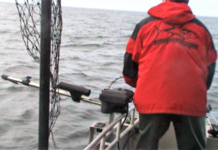
The deep-sea scyphozoan jellyfish, Atolla wyvillei, as seen under white light. Image courtesy of Edith A. Widder, Operation Deep Scope 2005 Exploration, NOAA-OE.
Did You Know?
Some jellyfish have clear bodies yet their stomachs are red. This is because the jellies are transparent in water and cannot be seen; however, if a jelly eats something that is NOT transparent, having a red stomach helps to hide the jelly’s last meal! If the stomach were transparent like the rest of the animal, other animals might be able to see the stomach contents.
Scientists are continually working to see the oceans through a new set of technological ‘eyes,’ by developing advanced, unobtrusive technologies to see animals and behaviors never before witnessed by humans. The more we see, the more we learn.
As you travel from surface waters to deeper waters, the quantity of light changes; it decreases with depth. The quality of light also varies with depth. Sunlight contains all of the colors of our visible spectrum (red, orange, yellow, green, blue, and violet). These colors combined together appear white.
Red light has the longest wavelength and, therefore, the least amount of energy in the visible spectrum. Wavelength decreases and energy increases as you move from red to violet light across the spectrum in the following order: red, orange, yellow, green, blue, and violet.
As light wavelength decreases from red to blue light, so does the ability of light to penetrate water. Blue light penetrates best, green light is second, yellow light is third, followed by orange light and red light. Red light is quickly filtered from water as depth increases.
All objects that are not transparent or translucent either absorb or reflect nearly all of the light that strikes them. When struck by white light (containing all colors), a red fish reflects red light and absorbs all other colors. Likewise, grass reflects green light and absorbs all other colors. White objects appear white because they reflect all colors of light in the visible spectrum. Black objects appear black because they absorb all colors of light.
Now consider that red fish. If a red fish is swimming at the surface of the ocean, it appears red because it reflects red light. However, the deeper you and the fish go, the less red the fish will appear, because there is less and less red light to reflect off of the fish. At 100 meters, red light does not penetrate and, at this depth, a red fish is difficult, if not impossible to see. Instead, the fish appears blackish because there is no red light to reflect at that depth and the fish absorbs all other wavelengths of color.
In the twilight zone, there are numerous animals that are black or red. At depth, these animals are not visible. The black animals absorb all colors of light available and the red animals appear black as well; there is no red light to reflect and their bodies absorb all other available wavelengths of light. Thus red and black animals predominate.
Since the color blue penetrates best in water, there simply are not that many blue animals in the midwater regions of the ocean; their entire bodies would reflect the blue light and they would be highly visible to predators.
For More Information:
What’s Bright Red and Invisible? (pdf, 173 kb), Hudson Canyon Cruise 2002
Blinded by the Light (pdf, 175 kb), Islands in the Stream 2002
Deep Light, Operation Deep Scope 2004
Sign up for the Ocean Explorer E-mail Update List.














